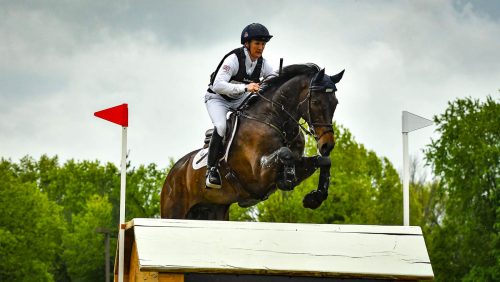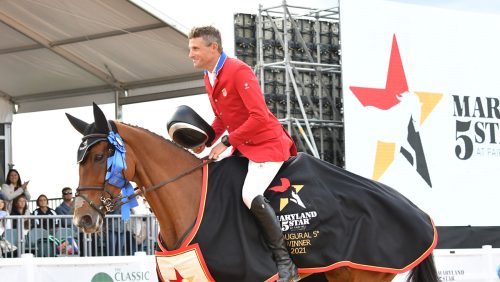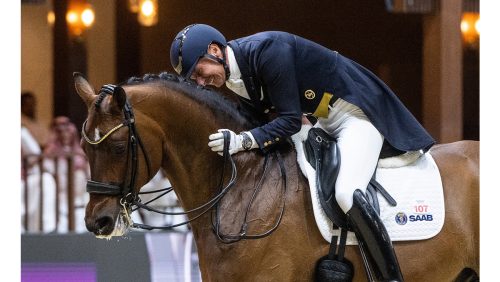The Chronicle of the Horse is celebrating its 85th birthday in 2022. For eight weeks leading up to the publication of our 85th Anniversary Issue, we’re bringing you a decade-by-decade look at the history that has filled its pages since 1937.
Plenty of major changes swept through the equestrian community during the 1970s. In international competition, the U.S. Equestrian Team was a major international force, with show jumping, dressage and eventing squads sweeping the 1975 Pan American Games (Mexico City) gold medals, and all three teams earning medals over the course of the Olympic Games in Munich (1972) and Montreal (1976).
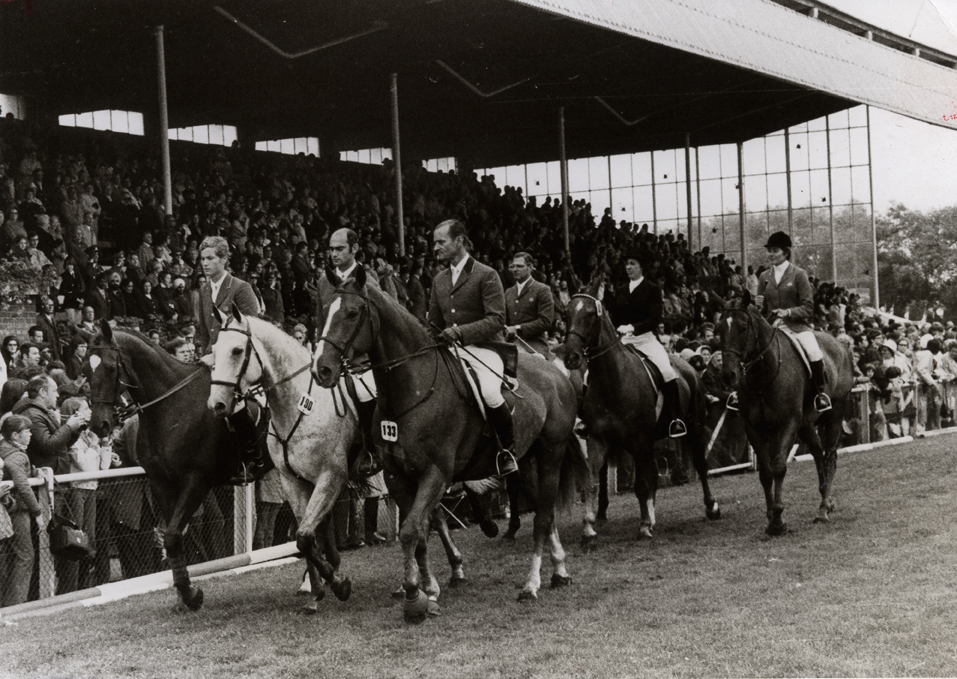
The American competitors at the Aachen CHIO in 1972, (from left) Robert Ridland, Neal Shapiro, Bill Steinkraus, Frank Chapot, Edith Master and Kathy Kusner, toured the arena. The U.S. show jumpers finished third in the Prix des Nations competition. Pressebild Guido Wedding Photo
Stateside, Rodney Jenkins dominated the grand prix and hunter circuits, eventually becoming the first professional who earned a spot on the U.S. Equestrian Team. U.S. dressage gained a major foothold, thanks in no small part to the formation of the U.S. Dressage Federation in 1973.
Jack LeGoff signed on as the eventing chef d’equipe in 1970, ushering in an astounding decade highlighted by team silver and gold medals in the 1972 and 1976 Olympic Games respectively, and individual gold (Tad Coffin) and silver (Michael Plumb) medals in 1976.
After Bruce Davidson led a near-U.S. sweep at the 1974 Eventing World Championships at Burghley (England), the United States earned the right to host the next edition. But the country had to come up with a venue to rival Burghley’s 16th century castle and historic grounds. This prompted a $26 million renovation of a lovely property in the heart of the Bluegrass State in anticipation of the 1978 World Championships, at that time the most important international equestrian event held in the United States since the 1932 Olympic Games in Los Angeles.
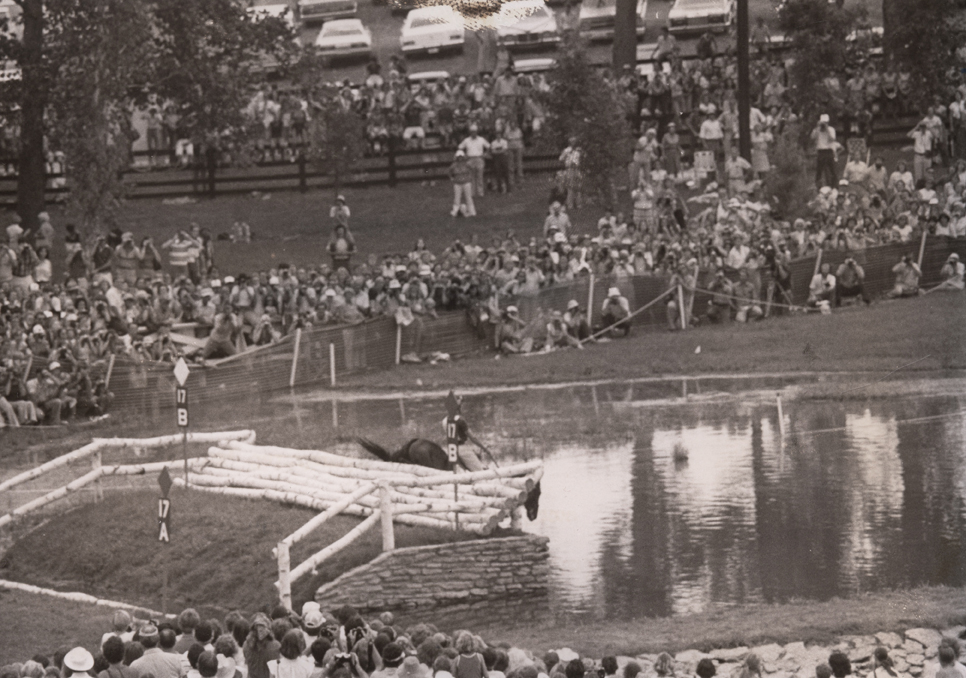
Bally Cor and Tad Coffin jumped into the Head of the Lake at the 1978 World Championships at Lexington, Ky. The drop that year was 5’11” approached just after a 4’11” ditch. Winants Photo
In Middleburg
The decade began with Alexander Mackay-Smith at the helm of The Chronicle of the Horse as editor. Regular contributor Peter Winants took over in 1976. (Mackay-Smith stayed on as the international editor.) The magazine covered combined training, dressage, jumpers, show hunters, fox hunting, hound shows, driving, polo, endurance, steeplechasing and flat racing. Thoroughbreds still reigned supreme, but so-called “near-breds” and warmbloods were entering the scene as well.
By the time the decade got rolling, the small amount of space still dedicated to the social side of horse sports dwindled to its current level in favor of more reports from ringside and ever-deeper analyses of the issues of the day. But short amusing anecdotes still punctuated the In The Country section.
For example there’s a notation in 1973 when German show jumping champion Alwin Schockemohle returned home and opened his suitcases to discover that, despite his combination locks, professional thieves had stolen his considerable prize money. Or the one in 1971 relating how Ralph Caristo and his young daughter helped police apprehend looters who were ransacking cars at a show at Knoll Farm (New York). The thieves were eventually led away with lead shanks wrapped around them and the wallets retrieved.
Equestrian Issues
The letters column in the magazine read like the Chronicle Forums of today, with readers debating timely topics like whether X-rays should be used in pre-purchase exams (some veterinarians argued this new technology confused more than educated), the merits of the new fad of using video as a training tool, whether shaggy-haired boys could be induced to wear hair nets, women entering the world of flat racing, the use of hackamores in the hunter ring, the use of twisted wire bits anywhere, the possibility of eliminating weights in combined training, how to deal with diseases like equine infectious anemia and Venezuelan equine encephalitis and the amateur rule at the Olympic Games.
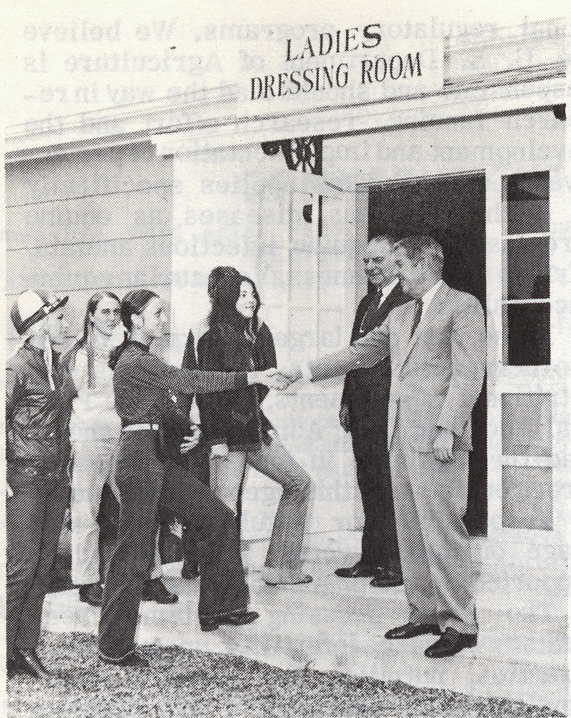
On June 25, 1971, the Chronicle ran this photo of the opening of the ladies locker room on Belmont Backstretch to accommodate the “growing corps of girl grooms and exercise riders.” A.G. Vanderbilt (right), chairman of the board of the New York Racing Association, and NYRA president F.M. Basil welcomed (from left) Donna Hillman, Deborah Maloney, Vickie Venderosa, Kaye Belle and Frannie Antonucci. Bob Coglianese. NYRA Photo
The so-called “martingale fracas,” in which readers and columnists debated the proper use of the standing martingale on and off for most of the decade, was neatly summed up by a reader who quoted a poem from Piero Santini:
There are those who love the martingale
And those who loathe its use
Some seem to like it very tight
While others use it loose.
Whichever view the student shares,
The pros and cons aren’t few
One must admit their handiness
When we aren’t sure what to do.
Some of the conversations ring familiar to modern ears, such as the proper use of draw reins, lack of television coverage of horse sports, whether show hunters are becoming too artificial, how to improve dressage judging, the difficulty of tracking the breeding of hunters and equitation horses at horse shows, whether big business was ruining the junior hunter divisions as “professional juniors” regularly swept the classes, and whether braiding should be banned.
“It feminizes the sport of showing,” argued one Thomas Davis Jr. “Most boys and male grooms just will not braid.” He also argued that other sportsmen ridicule show hunters as “they don’t braid the tails of setters in bench shows or field trails, or put bows on the Labradors.”
Political Issues On The Rise
ADVERTISEMENT
Insulated though it may be, the horse world certainly wasn’t immune to the most charged issues of the day. On Aug. 25, 1972, the Chronicle ran a short news item relating the conviction of two men, described as black activists, in Charlotte, North Carolina. After a white stable owner refused to rent the men horses in 1968, the men returned to firebomb the stable, killing the 15 horses inside. “[The judge] told Grant that there was a lot yet to be done in race relations. But ‘the objective is defeated’ when the means are violent.”
The energy crisis and gas rationing had horsemen tightening their belts and led the U.S. government to explore using manure as a source of fuel for domestic and industrial energy needs. Many stayed close to home to save fuel.
The women’s liberation movement took a little extra time for more traditional horsemen to get used to, and cartoons and letters published in the earlier part of the decade wouldn’t pass muster today.
The Chronicle ran a photo of the “Women’s Locker Room at Belmont Park” opening in the same issue in the spring of 1971 as a reader-submitted piece titled “Horses Are A Man’s Game.”
Meanwhile trailblazers like Kathy Kusner continued to fly around the world to jump in international competition, ride in races and generally break down barriers. By mid-decade the popular sentiment was changing, and stories popped up about racetrack trainers who strongly preferred the work ethic and focus of their female employees. By the end of the decade, the battle of the sexes had adopted a more tongue-in-cheek tone, such as this Jan. 27, 1978, In the Country notation:
“A Texas rancher had to deal with the new Federal laws prohibiting job classification by sex. He ran the following ad in a local paper: ‘Cowperson wanted. Applicant must use profanity and share a bunkhouse with four male cowpersons who seldom bathe.’”
Drugs, Drugs, Drugs
But the biggest lightning rod surrounded drugging horses.
Following the General Assembly meeting in late 1977, the Fédération Equestre Internationale opted to continue the policy of allowing phenylbutazone in combined training and show jumping competitions, rather than banning it as they’d announced they would a year earlier. (Its use was banned in international dressage competition.) The United States voted against the ban, but the Chronicle took a firm stance, saying that the magazine “continues to unequivocally oppose the use of ‘Bute’ in horse sports, and we are extremely disappointed in the inconclusive, wishy-washy approach of the FEI at Brussels in December 1977. At the same time, we have respect for Dr. O’Dea [a U.S. veterinarian who supported allowing bute in competition], and we welcome his in-depth analysis of the ‘Bute’ issue in a subsequent issue of the Chronicle.”
The Chronicle closely followed the American Horse Show Association’s drug testing program from its infancy, and the appointment of John Lengel to the post of Acting Administrator of the American Horse Shows Associations Drugs and Medications Program earned the lead spot in the In The Country section. And when the AHSA wanted feedback about the proposed drug rule changes, the association took out a full-page ad in the magazine.
On Mar. 24, 1978, AHSA President Richard E. McDevitt wrote a guest commentary titled “AHSA All Out To Stamp Out Drugging.”
“…From time to time, I hear rumors that we are about to give up because of the mounting costs and the fact that certain drugs are still undetectable. That would be the easy way out, and not the way we choose to go.”
That commentary came in response to the drug du jour, reserpine. In 1978 the AHSA finally developed a test for the drug just in time for the Devon Horse Show (Pennsylvania), and 25 exhibitors were fined that very week for using the drug, many at the prestigious Pennsylvania show itself.
The Year That Started It All
The Chronicle sent two editors to report on the 1978 World Three-Day Eventing Championships at the Kentucky Horse Park. Like today, huge flocks of spectators flocked to Lexington for what would become the Land Rover Kentucky Three-Day Event CCI5*.
Though his 1974 winner Irish Cap went lame, Davidson’s younger and greener Might Tango stepped up to help Davidson become the first rider to win two consecutive World Championship titles.
ADVERTISEMENT
Questions abounded over the difficulty of the speed and endurance phases at Kentucky, as half of the starting field didn’t complete the event, prompting, among other things, a panel discussion titled “Can The International Three-Day Event Be Saved” at a USCTA seminar at Morven Park International Equestrian Institute (Virginia). (Yes it can, as it turns out.) LeGoff suggested eliminating roads and tracks.
But a darker event at the championship had a major effect on U.S. horse sports. Caroline Treviranus suffered a serious head injury in the stadium phase in front of that huge crowd while wearing a hunt cap that didn’t stay on during the fall. This accident prompted the USCTA to mandate that all hard hats must have safety harnesses in competition over fences.
Two weeks after the accident, the Chronicle ran an inflammatory guest commentary by Clarke Cassidy Jr., a USCTA board member and member of the Advisory Committee for the U.S. Pony Club, calling for sports medicine professionals, equestrians and the Snell Foundation (a nonprofit dedicated to helmet safety through medical and scientific research) to “cut through the thicket of custom and prejudice which to date has discouraged manufactures from developing caps that incorporate the minor changes in shape to achieve Snell Foundation approval. This proposed panel must establish a timetable for the eventual required use of such caps in all competition.”
Following that editorial, the Committee for Equestrian Protective Headgear convened, paving the way for helmet safety standards, which hitherto didn’t exist. And following that meeting, the Chronicle announced on Feb 2, 1979, that, despite frequent submissions that violated the precept, the magazine would no longer publish “either editorially or in ads, pictures where riders fail to wear a hard hat [while jumping].”
Horse Show Land
In the 1970s riders auditioned for a spot on the U.S. Equestrian Team, which made the rounds, among other places, to the fall indoor circuit to compete against top squads from around the world. Starting in 1978 these shows were major stops on the new World Cup circuit.
When Neal Shapiro and Sloopy earned individual show jumping bronze at Munich, the Chronicle celebrated by running a photo of him and Sloopy on the cover. The team (Shapiro, Bill Steinkraus, Kusner and Frank Chapot) earned silver for the United States, missing out on bronze by a mere point in the 1976 edition.

Jenkins seemed to win something every week, often a major grand prix aboard the legendary Idle Dice, or else nearly every open hunter championship at the horse show. And Charlie Weaver seemed to win most of those hunter classes Jenkins didn’t, often aboard Stocking Stuffer. Melanie Smith (now Taylor) was starting to turn more heads as she progressed to a winning grand prix rider by the end of the decade aboard “the Dutch-bred Calypso.”
George Morris churned out top riders from his Hunterdon Stable like Buddy Brown and Katie Monahan (now Prudent), who started the decade as the preeminent junior rider on the circuit and finished it by placing second in the very first World Cup Show Jumping Final (Sweden) aboard The Jones Boy in 1979. (After she won the 1972 AHSA Medal Finals on a Thoroughbred she borrowed from Chrystine Jones [now Tauber], Morris said, “She’s a smooth rider who can handle a horse as well as a man…She’s authoritative and has strength on a horse.”)
And in 1971 the so-called “number system,” wherein judges awarded a score of 1-100 for a hunter round, debuted at the Winter Haven (Florida) show circuit, put on by one Gene Mische, to cautiously optimistic reviews.
Down Centerline
At the start of the decade, the United States dressage enthusiasts struggled to get grassroots momentum and become internationally competitive. Training debates raged in the letters section of the magazine, with experts like Col. Benjt Lundquist and Axel Steiner weighing in.
But there was plenty of progress. The dressage competition at Munich started a day late thanks to the so-called Munich Massacre (wherein members of the Israeli Olympic team were taken hostage and eventually killed by a Palestinian terrorist group). According to Max E. Ammann’s Oct. 20, 1972, report, the United States initially considered not sending a squad thanks to slow progress, but performed better than expected, with the exception of a “rough ride” by Lois Stephens and Fasching, which dragged the team down to second last. (The team only beat Great Britain.)
Meanwhile the Chronicle documented the career of Hilda Gurney’s Keen, starting from the Thoroughbred’s Prix St. Georges debut (as a 6-year-old to marks of 68 percent) to leading the United States to an unexpected team bronze medal in Montreal.
Read about all the decades of the Chronicle: the 1930s and 1940s | the 1950s | the 1960s | the 1970s | the 1980s | the 1990s | the 2000s


















